belt CHEVROLET CAMARO 1994 4.G User Guide
[x] Cancel search | Manufacturer: CHEVROLET, Model Year: 1994, Model line: CAMARO, Model: CHEVROLET CAMARO 1994 4.GPages: 292, PDF Size: 15.35 MB
Page 25 of 292
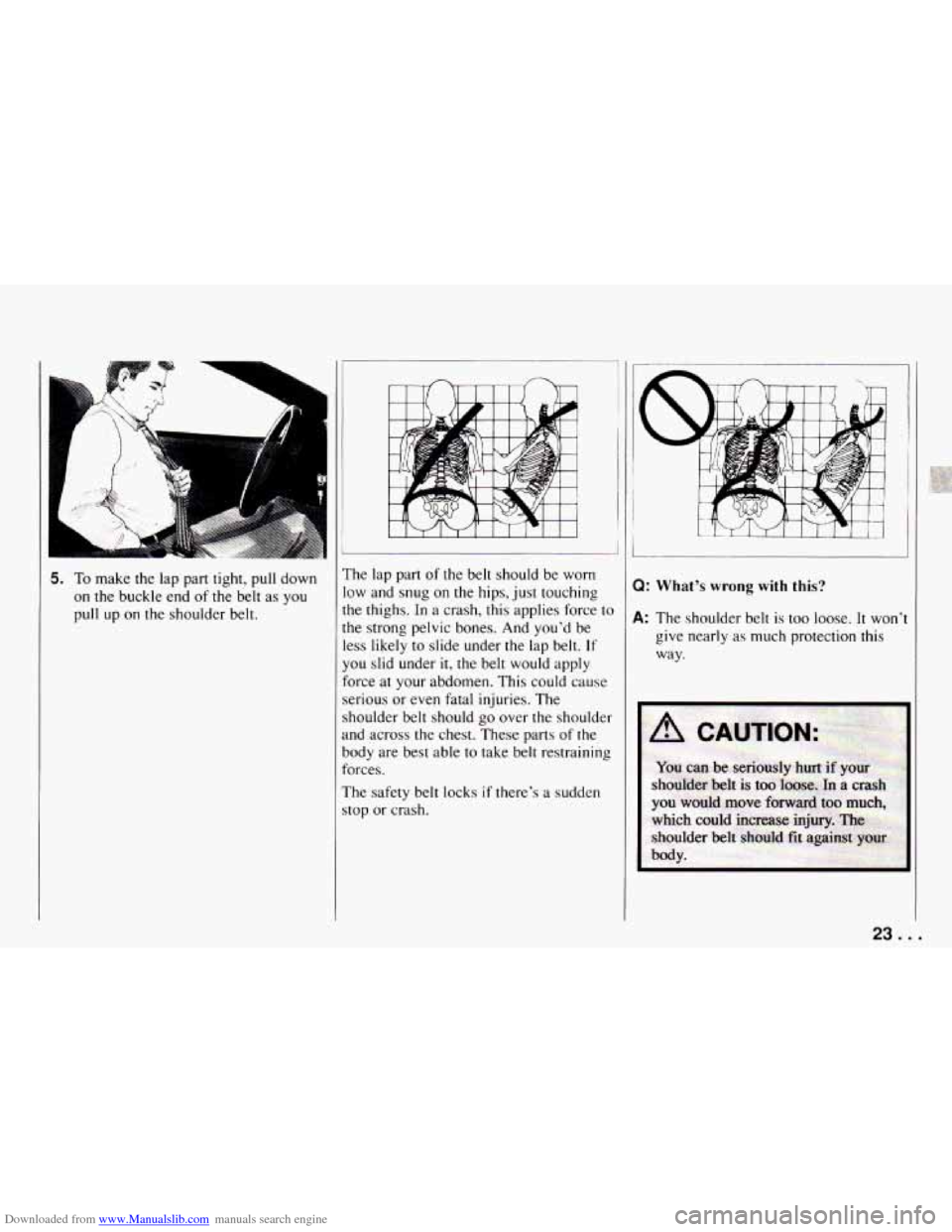
Downloaded from www.Manualslib.com manuals search engine 5. To make the lap part tight, pull down
on the buckle end
of the belt as you
pull up on the shoulder belt. ’he
lap part
of the belt should be worn
ow and snug on the hips, just touching
he thighs. In a crash, this applies force to
he strong pelvic bones. And you’d be
zss likely to slide under the lap belt. If
‘ou slid under it, the belt would apply
orce at your abdomen. This could cause
erious or even
fatal injuries. The
houlder belt should go over the shoulder
nd across the chest. These parts
of the
lody are best able to take belt restraining
orces.
’he safety belt locks
if there’s a sudden
top or crash.
: What’s wrong with this?
: The shoulder belt is too loose. It won7
give nearly as much protection this
way.
23. .
Page 26 of 292
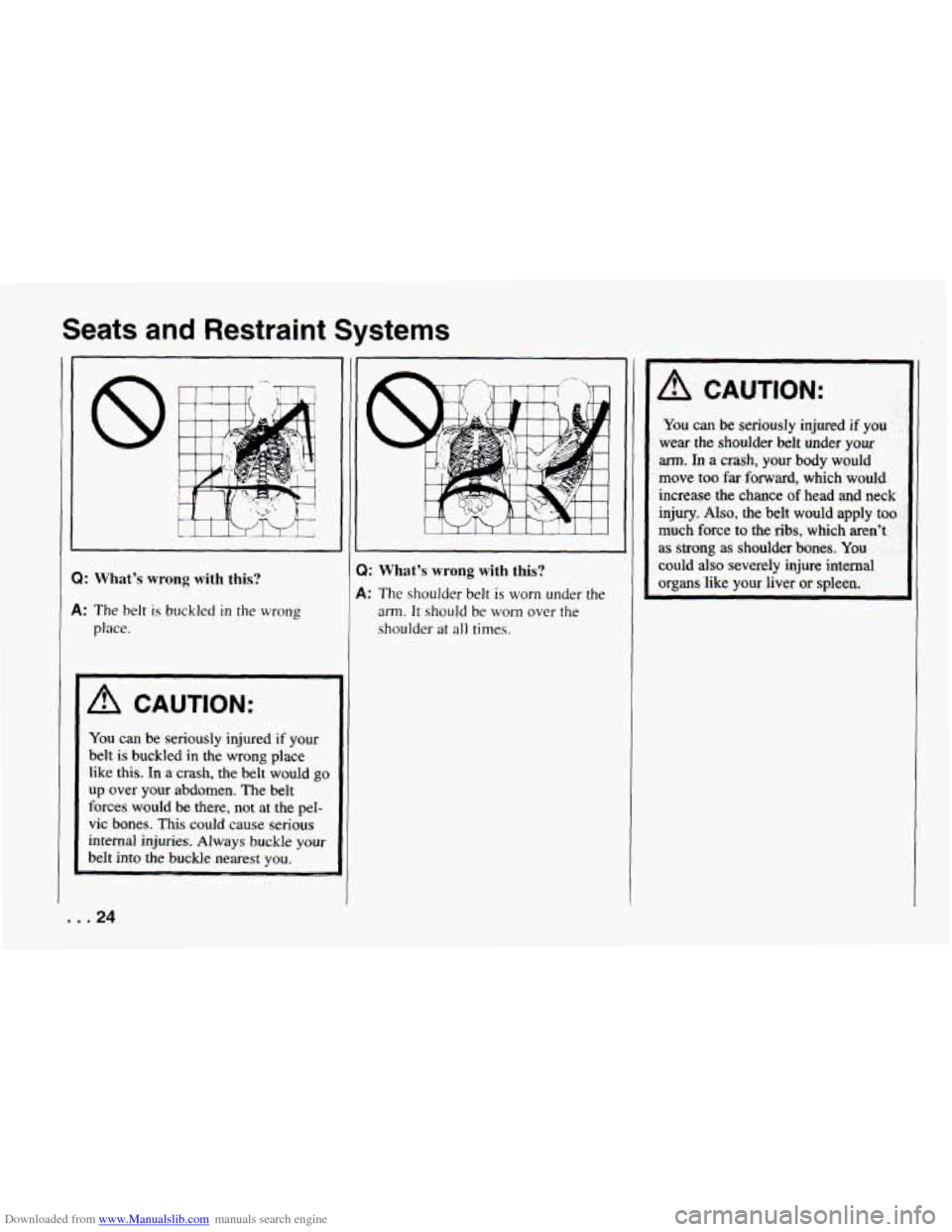
Downloaded from www.Manualslib.com manuals search engine Seats and Restraint Systems
8
I
Q: What’s wrong with this?
A: The belt is buckled in the wrong
place.
A CAUTION:
You can be seriously injured if your
belt is buckled in the wrong place
like this. In a crash, the belt would go
up over your abdomen. The belt
forces would be there, not at the pel-
vic bones. This could cause serious
internal injuries. Always buckle your
belt into the buckle nearest you.
1
Q: What’s wrong with this?
A: The shoulder belt is worn under the
arm. It should be worn over the
shoulder at
all times.
A CAUTION: I
wear the shoulder belt under your
arm. In a crash, your body would
move too far forward, which would
increase the chance of head and neck
injury. Also, the belt wuuld apply too
much force to the ribs, which aren’t
as strong as shoulder bones. You
could also severely injure internal
organs
like your liver or spleen.
... 24
Page 27 of 292
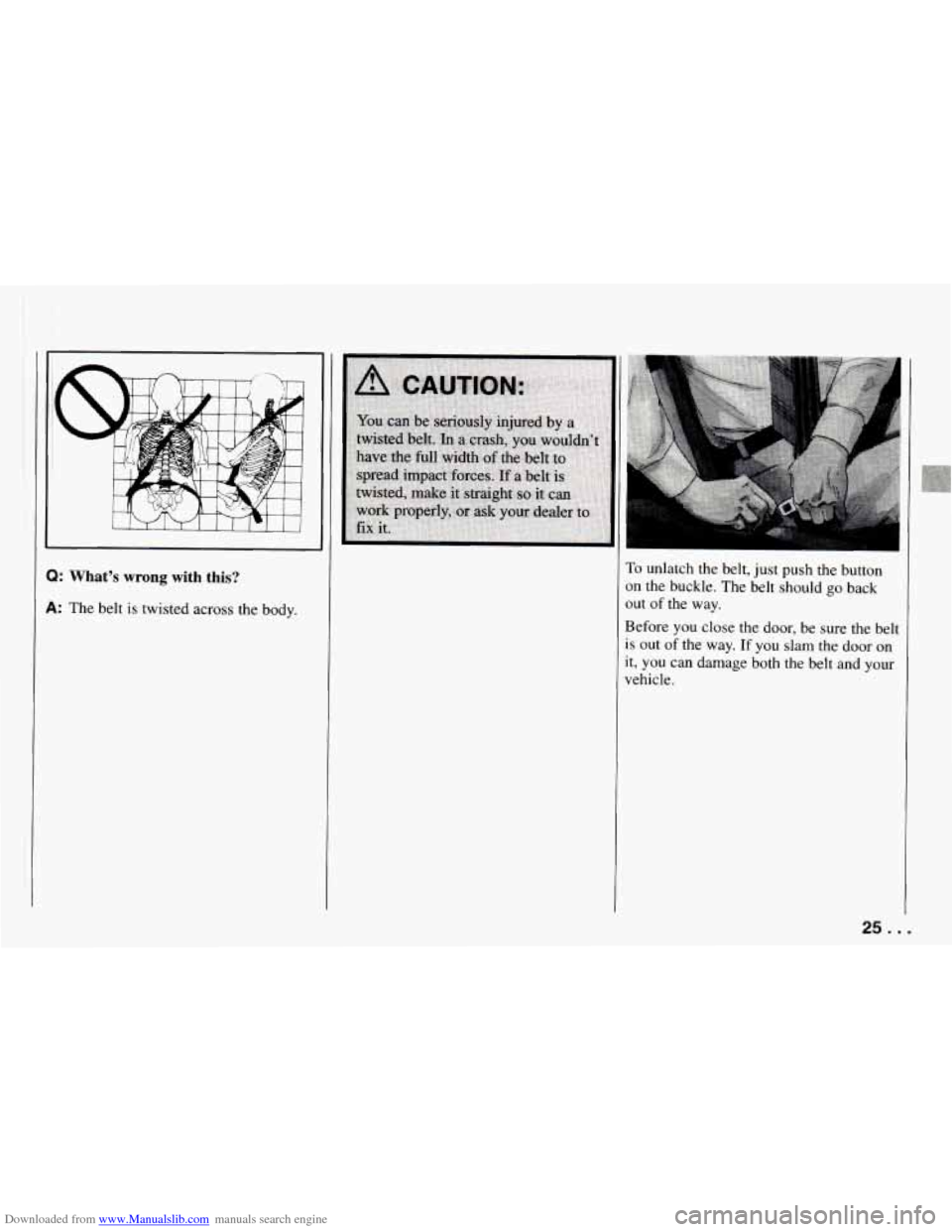
Downloaded from www.Manualslib.com manuals search engine I
Q: What’s wrong with this?
A: The belt is twisted across the body.
To unlatch the belt, just push the button
on the buckle. The belt should go back
out of the way.
Before you close the door, be sure
the belt
is out of the way. If you slam the door on
it, you can damage both the belt and your
vehicle.
25 ...
Page 28 of 292
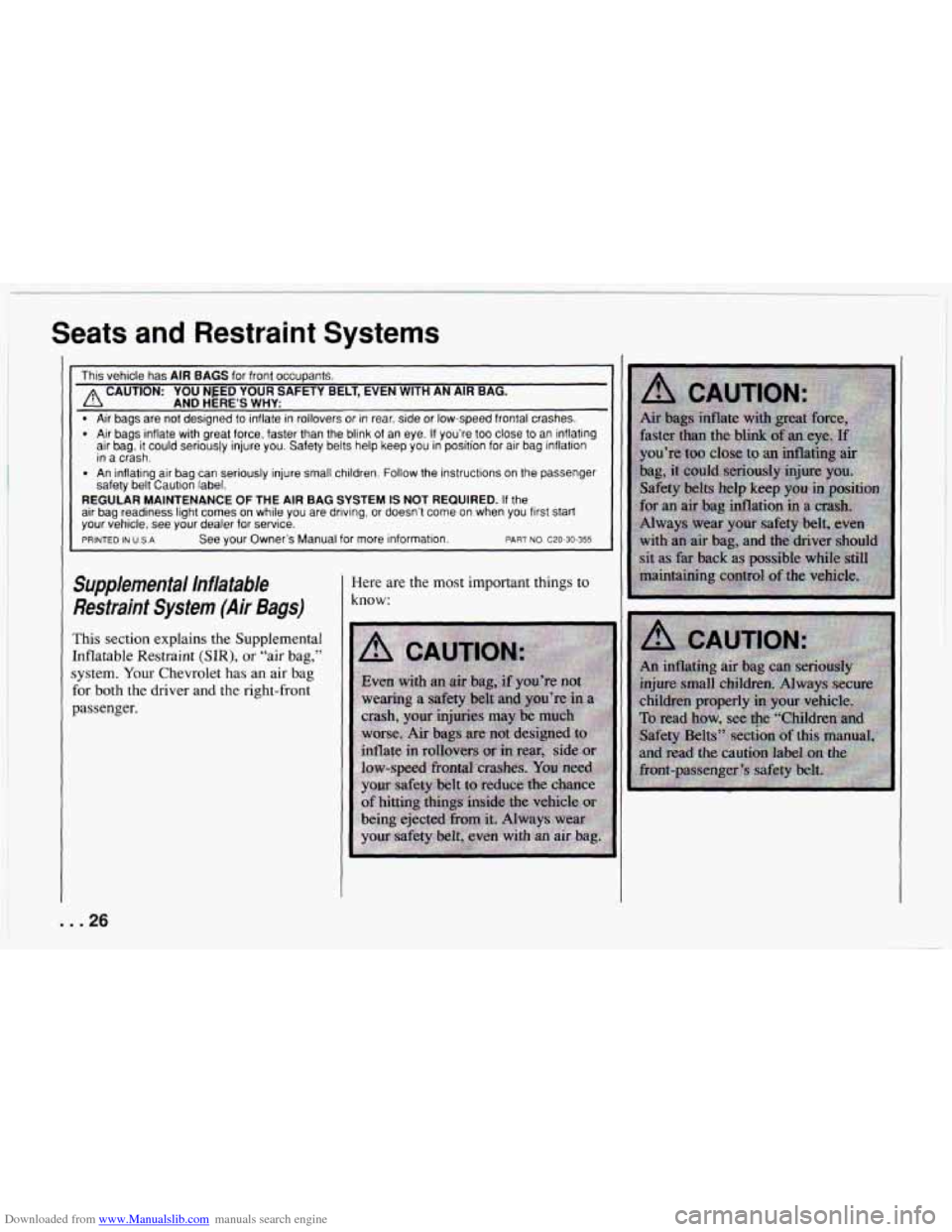
Downloaded from www.Manualslib.com manuals search engine ’ Seats and Restraint Systems
This vehicle has AIR BAGS for front occupants.
A CAUTION: YOU NEED YOUR SAFETY BELT, EVEN WITH AN AIR BAG.
AND HERE’S WHY:
Air bags are not designed to inflate in rollovers or in rear, side or low-speed frontal crashes.
Air bags inflate with great force, faster than the blink of an eye.
If you’re too close to an inflating
air bag, it could seriously injure you. Safety belts help keep\
you in position for air bag inflation
in a crash.
. An inflating air bag can seriously injure small children. Follow t\
he instructions on the passenger
safety belt Caution label.
REGULAR MAINTENANCE OF THE AIR BAG SYSTEM IS NOT REQUIRED. If the
air bag readiness light comes on while you are driving, or doesn’t come on when you first start
your vehicle, see your dealer for service.
PRINTED IN U.5.A See your Owner’s Manual for more information. PART NO. C20-30-355
Supplemental lnfhtable
Restraint System (Air Bags)
This section explains the Supplemental
Inflatable Restraint
(SIR), or “air bag,”
system.
Your Chevrolet has an air bag
for both the driver
and the right-front
passenger. Here
are the most important things to
know:
... 26
Page 31 of 292
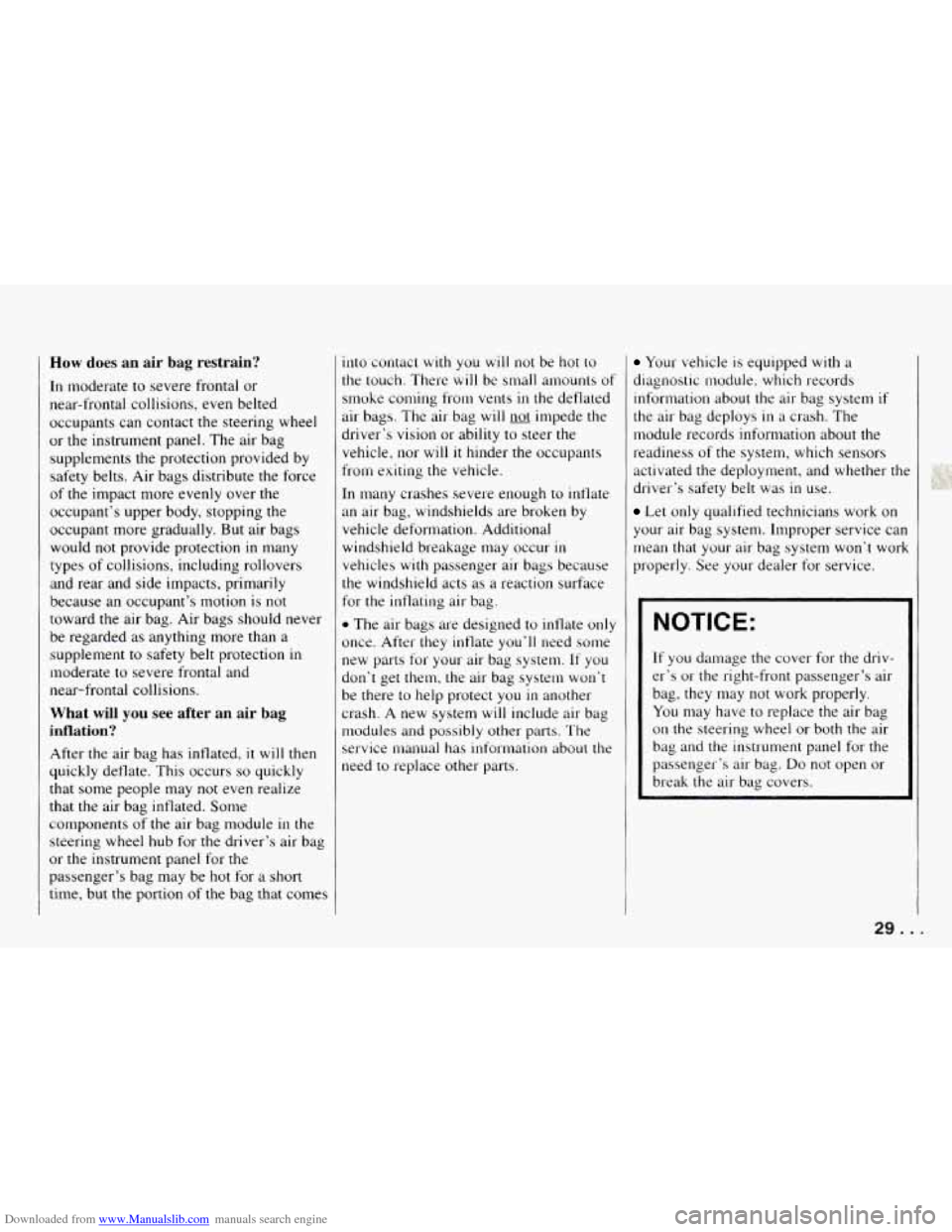
Downloaded from www.Manualslib.com manuals search engine How does an air bag restrain?
In moderate to severe frontal or
near-frontal collisions, even belted
occupants can contact the steering wheel
or the instrument panel. The air bag
supplements the protection provided by
safety belts. Air bags distribute the force
of the impact more evenly over the
occupant’s upper body, stopping the
occupant more gradually. But air bags
would not provide protection in many
types
of collisions, including rollovers
and rear and side impacts, primarily
because an occupant’s motion is not
toward the air bag. Air bags should never
be regarded as anything more than a
supplement to safety belt protection in
moderate to severe frontal and
near-frontal collisions.
What will you see after an air bag
inflation?
After the air bag has inflated, it will then
quickly deflate. This occurs
so quickly
that some people may
not even realize
that the air bag inflated. Some
components of the air bag module
in the
steering wheel hub for the driver’s air bag
or the instrument panel for the
passenger’s bag may be hot for a short
time, but the portion of the bag that comes
into contact .with you will not be hot to
the touch. There will be small amounts of
smoke coming from vents in the deflated
air bags. The air bag will
rn impede the
driver’s vision or ability to steer the
vehicle, nor will
it hinder the occupants
from exiting the vehicle.
In many crashes severe enough to inflate
an air bag, windshields are broken by
vehicle deformation. Additional
windshield breakage may occur
in
vehicles with passenger air bags because
the windshield acts as a reaction surface
for the inflating air bag.
0 The air bags are designed to inflate only
once. After they inflate you’ll need some
new parts for your air bag system.
If you
don’t get them, the air bag system won’t
be there to help protect you
in another
crash.
A new system will include air bag
modules and possibly other parts. The
service manual has information about the
need to replace other pans.
Your vehicle is equipped with a
diagnostic module. which records
information about the air bag system if
the air bag deploys
in a crash. The
module records information about the
readiness of the system, which sensors
activated the deployment, and whether
thr
driver’s safety belt was in use.
Let only qualified technicians work on
your air bag system. Improper service car
mean that your air bag system won’t work
properly. See your dealer for service.
If you damage the cover for the driv-
er’s
or the right-front passenger’s air
bag, they may not work properly.
You may have
tu replace the air bag
on the steering wheel or both the air
bag and the instrument panel for the
passenger’s air bag.
Do not open or
break the air bag covers.
29 ...
Page 33 of 292
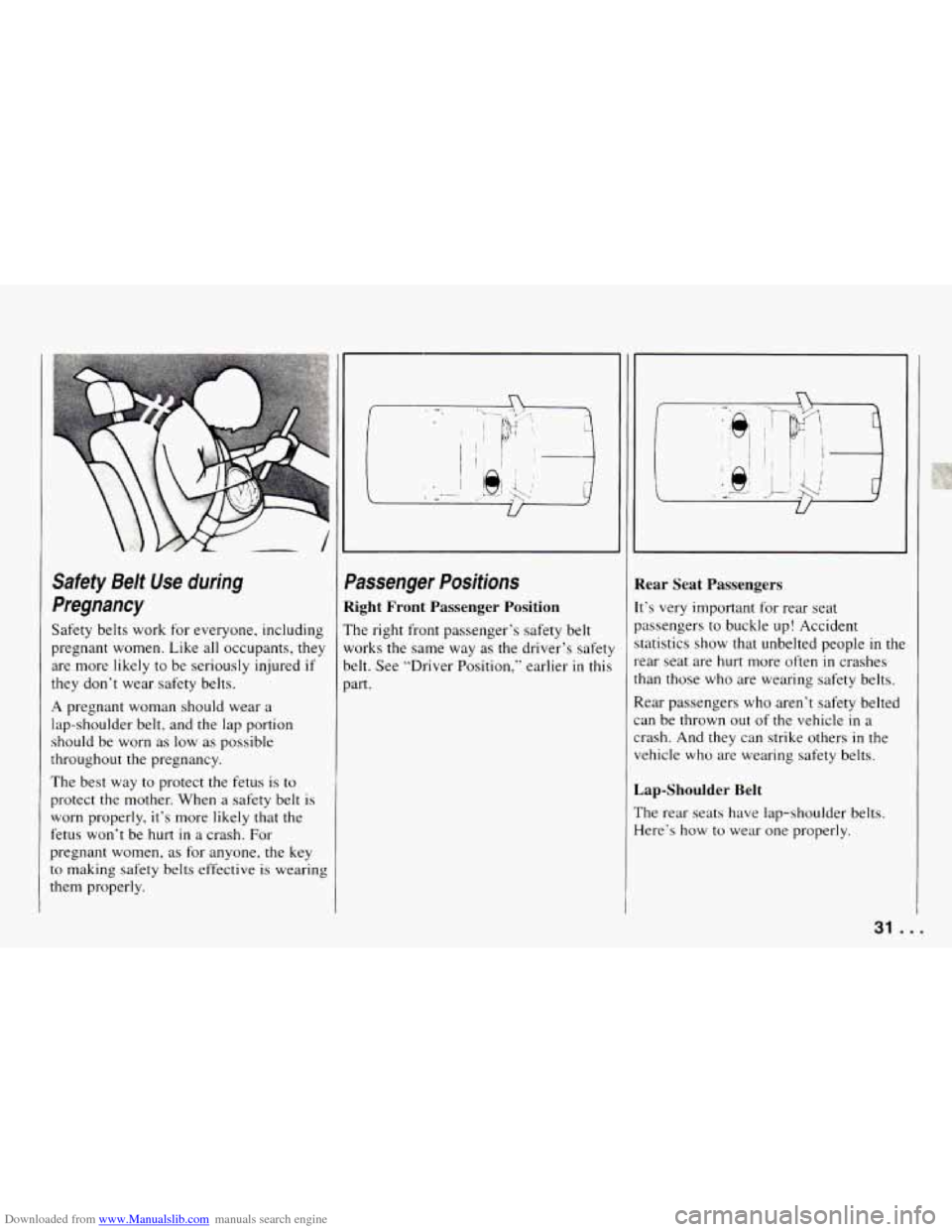
Downloaded from www.Manualslib.com manuals search engine Safety Belt Use during
Pregnancy
Safety belts work for everyone, including
pregnant women. Like all occupants, they
are more likely to be seriously injured if
they don’t wear safety belts.
A pregnant woman should wear a
lap-shoulder belt, and the lap portion
should be worn as low as possible
rhroughout the pregnancy.
The best way to protect the fetus is to
protect the mother. When a safety belt
is
worn properly, it’s more likely that the
fetus won’t be
hurt in a crash. For
pregnant women, as for anyone, the key
to making safety belts effective
is wearing
them properly.
-
!
Passenger Positions
Right Front Passenger Position
The right front passenger’s safety belt
works the same way as the driver’s safety
belt. See “Driver Position,” earlier
in this
part.
I . .. .
E
1;
P
rl
tl
F
S
C
C
V
I
T
I-
tear Seat Passengers
t’s very important for rear seat
tassengers to buckle up! Accident
tatistics show that unbelted people in the
ear seat are hurt more often in crashes
han those who are wearing safety belts.
:ear passengers who aren’t safety belted
an
be thrown out of the vehicle in a
rash. And they can strike others
in the
,chicle who are wearing safety belts.
.ap-Shoulder Belt
‘he rear seats have lap-shoulder belts.
lere’s how to wear one properly.
31 ...
Page 34 of 292
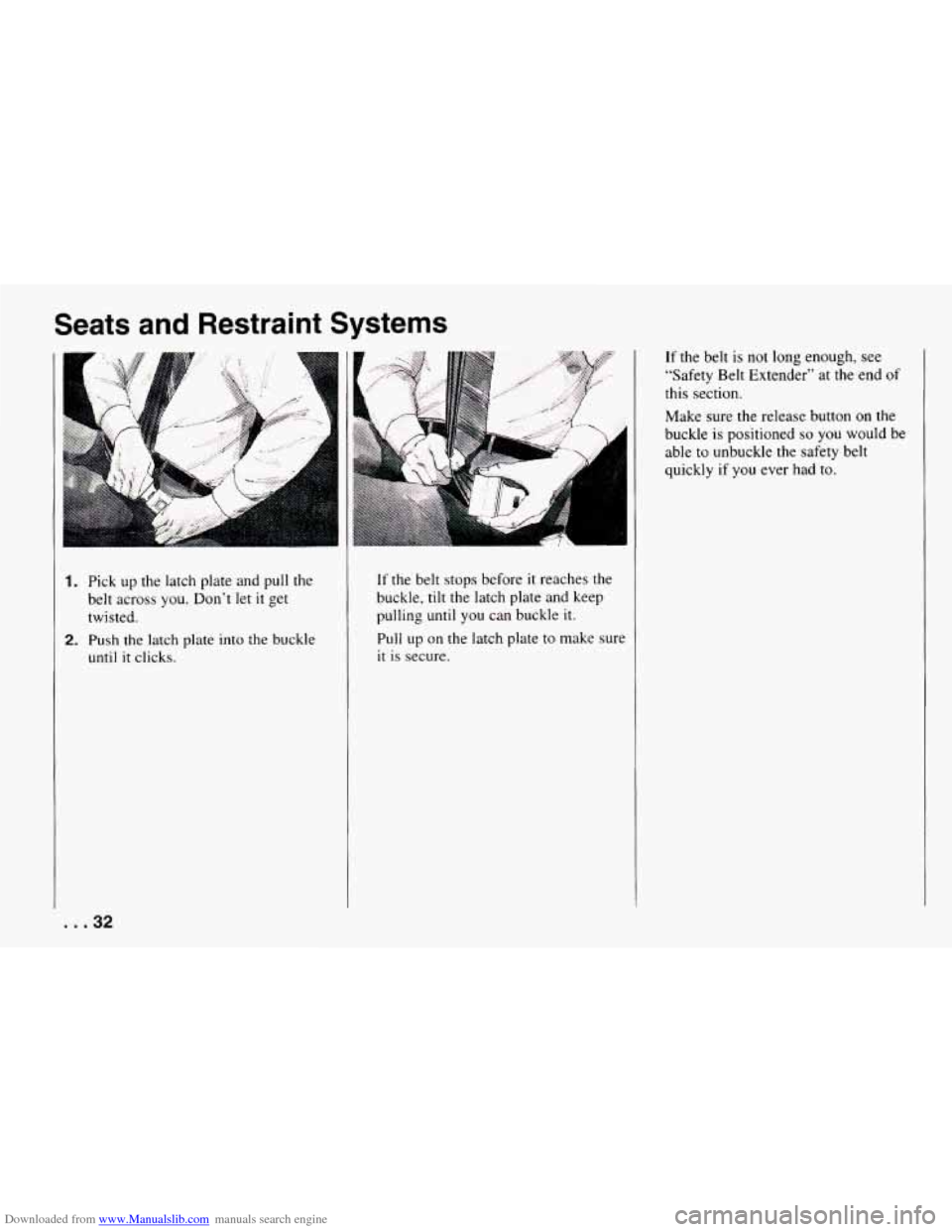
Downloaded from www.Manualslib.com manuals search engine Seats and Restraint Systems
1. Pick up the latch plate and pull the
belt across
you. Don’t let it get
twisted.
2. Push the latch plate into the buckle
until it clicks.
If the belt stops before it reaches the
buckle,
tilt the latch plate and keep
pulling until you can buckle it.
Pull up
on the latch plate to make sure
it is secure.
If the belt is not long enough, see
“Safety Belt Extender” at
the end of
this section.
Make sure the release button
on the
buckle
is positioned so you would be
able to unbuckle the safety belt
quickly
if you ever had to.
... 32
Page 35 of 292
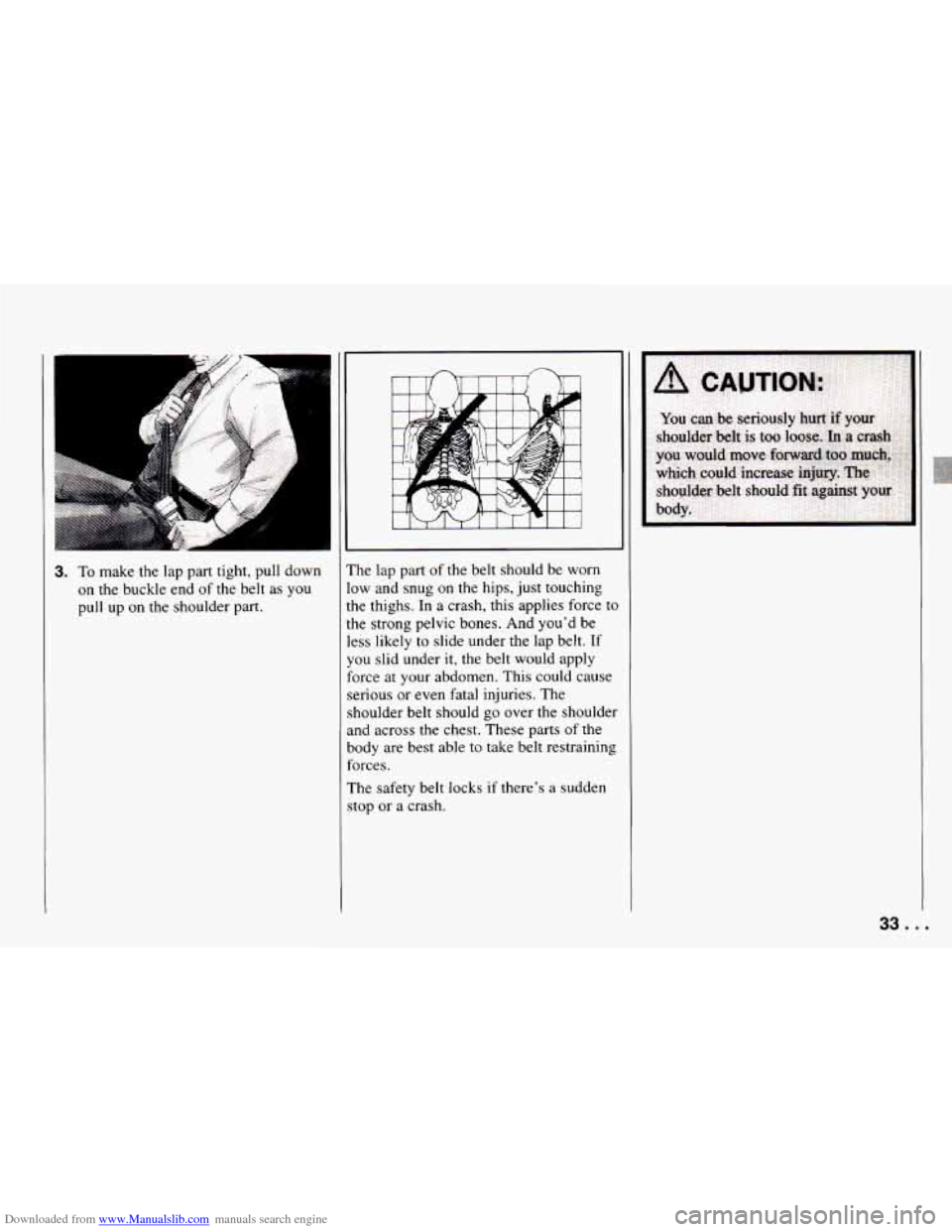
Downloaded from www.Manualslib.com manuals search engine 3. To make the lap part tight, pull down
on the buckle end of the belt
as you
pull up on the shoulder part. 'he
lap part of the belt should be worn 3w and snug on the hips, just touching
he thighs. In a crash, this applies force to
he strong pelvic bones. And you'd be
zss likely to slide under the lap belt. If
'ou slid under it, the belt would apply
orce at your abdomen. This could cause
erious or even fatal injuries. The
houlder belt should go over the shoulder
.nd across the chest. These parts
of the
,ody are best able to take belt restraining
.orces.
I'he safety belt locks if there's
a sudden
;top or a crash.
-9 Yb...
Page 36 of 292
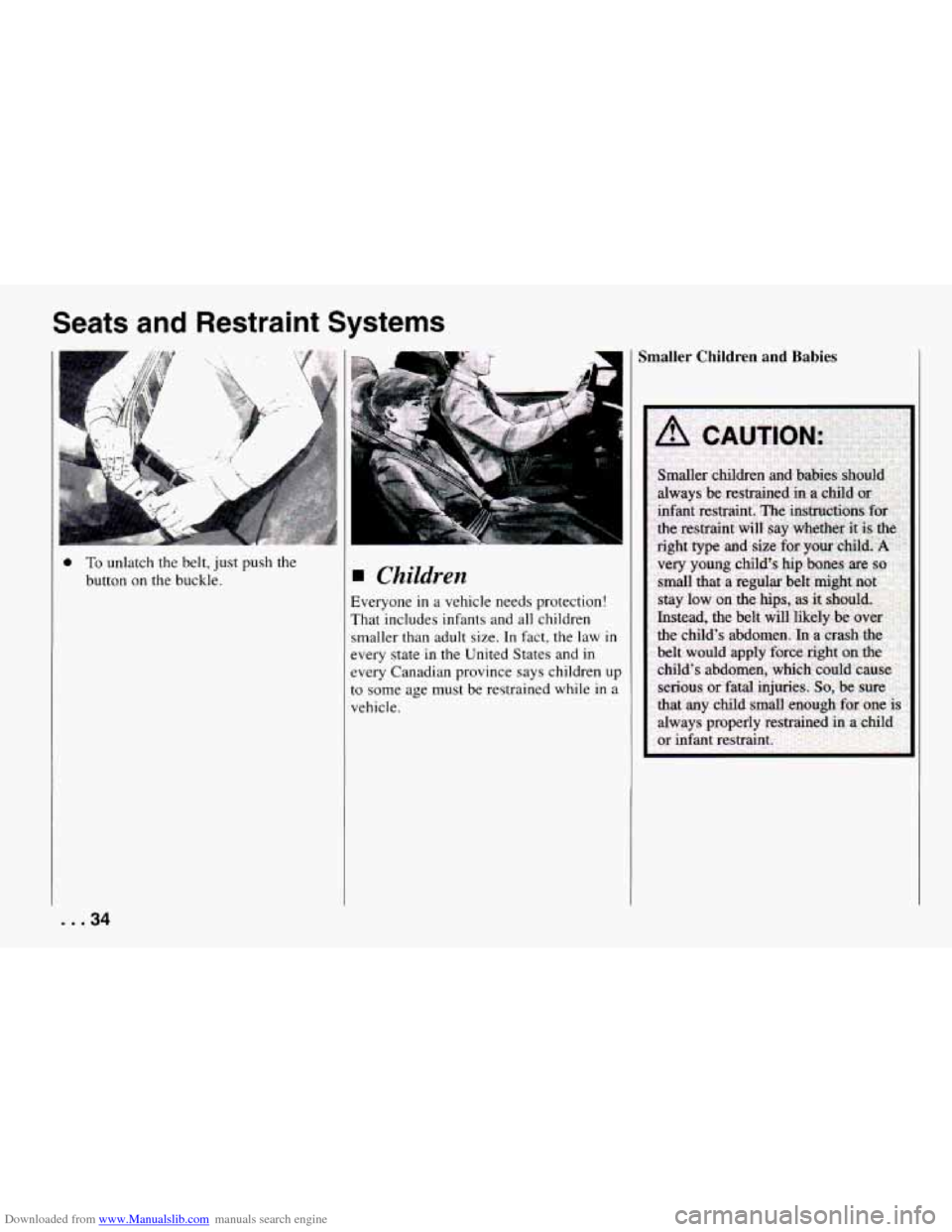
Downloaded from www.Manualslib.com manuals search engine Seats and Restraint Systems
t
0 To unlatch the belt, just push the
button on the buckle.
Children
Everyone in a vehicle needs protection!
That includes infants and all children
smaller than adult size. In fact, the law
in
every state in the United States and in
every Canadian province
says children up
to some age must be restrained while in a
vehicle.
Smaller Children and Babies
... 34
Page 37 of 292
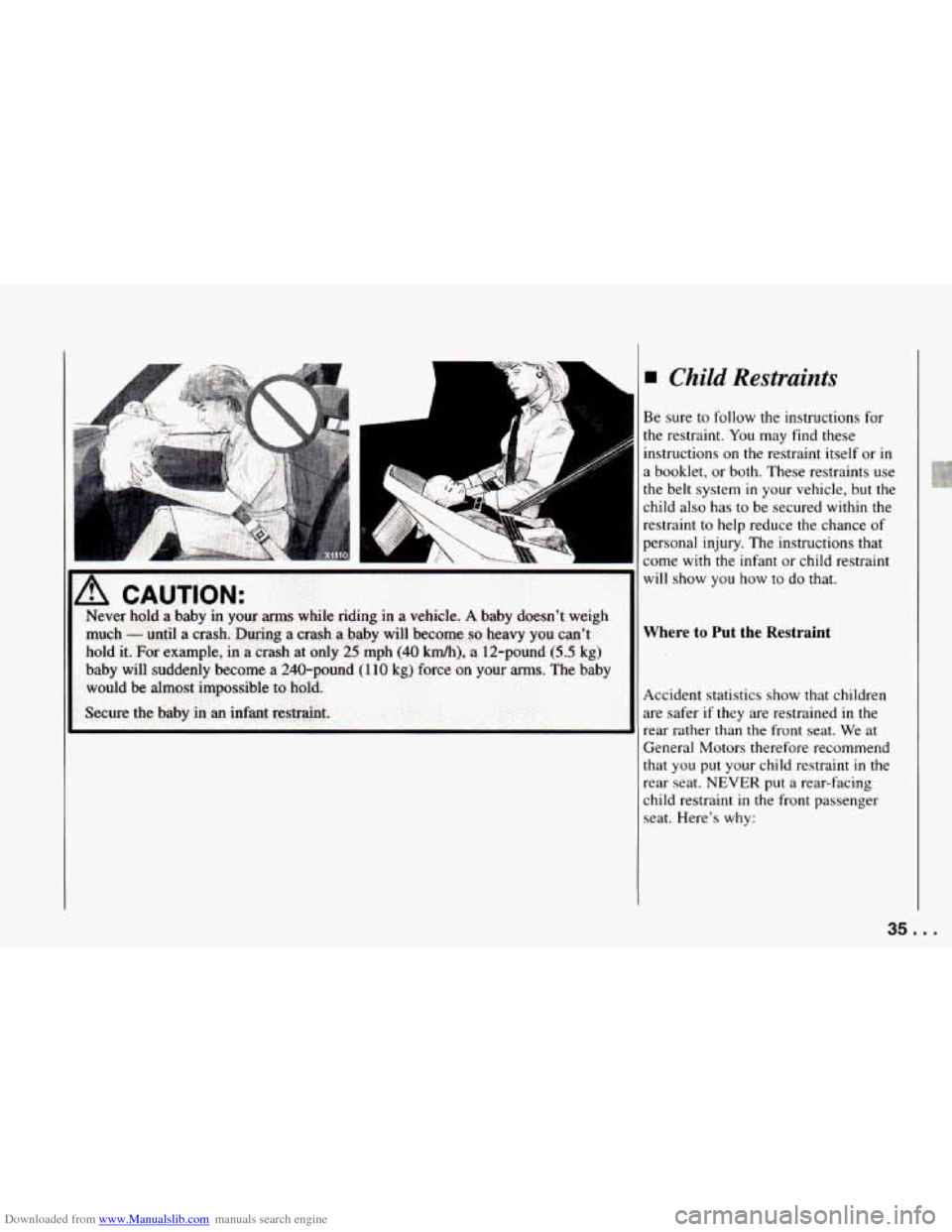
Downloaded from www.Manualslib.com manuals search engine ,,
Child Restraints
Be sure to follow the instructions for
the restraint.
You may find these
instructions on the restraint itself or in
a booklet, or both. These restraints use
the belt system
in your vehicle, but the
child also has to be secured within the
restraint to help reduce the chance
of
personal injury. The instructions that
come
with the infant or child restraint
baby will. suddenly become a 240-pound (1 10 kg) force on your-arms. The baby
would be almost impossible tu hold.
Secure the baby in an infant regint. I
will show you how to do that.
Where to Put the Restraint
Accident statistics show that children
are safer if they are restrained in the
General Motors therefore recommend
that
you put your child restraint in the
rear seat.
NEVER put a rear-facing
child restraint in the front passenger
seat. Here's why:
35 ...